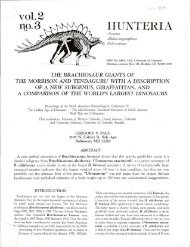THE MANY MYTHS, SOME OLD, SOME NEW, OF ... - Gregory S. Paul
THE MANY MYTHS, SOME OLD, SOME NEW, OF ... - Gregory S. Paul
THE MANY MYTHS, SOME OLD, SOME NEW, OF ... - Gregory S. Paul
Create successful ePaper yourself
Turn your PDF publications into a flip-book with our unique Google optimized e-Paper software.
DINOSAUR <strong>MYTHS</strong> 81<br />
Reality: As shown above, low surface areas were an advantage, not a problem, for<br />
dinosaurs in extremely hot conditions, so radiators were not critical. Indeed, as<br />
environmental heat loads rise, it becomes increasingly difficult and eventually<br />
impossible to radiate heat out from a body, so radiators become ineffective when<br />
they are needed the most (Hiley, 1975, notes that the use of ears for cooling in<br />
elephants is limited to moderate temperatures). The importance of heat radiators to<br />
dinosaurs has been overstated.<br />
SAUROPODS WERE NOT BIG-MOU<strong>THE</strong>D ENOUGH<br />
TO BE TACHYMETABOLIC<br />
Myth: Ever since their skulls have been found, people have wondered how sauropods<br />
fed themselves. Currently, it is generally held that sauropod heads were too<br />
small and weak toothed for them to sustain a high rate of food consumption, so they<br />
are portrayed as relatively weak herbivores unable to sustain a high metabolic rate<br />
(McGowan, 1979; Ostrom, 1980, 1987; Regal and Gans, 1980; Halstead and<br />
Halstead, 1981; Weaver, 1983; Reid, 1984, 1987; Farlow, 1987; Coe et al., 1987;<br />
Russell, 1989).<br />
Reality: Complete nonsense. The heads of the biggest 40-80 tonners were as big as<br />
those of albertosaurs, massed 100 kg or more, could swallow a 70 kg body whole,<br />
and had cropping teeth much larger than those of giraffe's (Weaver's 1983 characterization<br />
of the head of Brachiosaurus as comparable to a giraffe's is therefore wholly<br />
false). Even the smallest adult diplodocid skulls were as big as those of large<br />
alligators, and were much broader than and had many more teeth than those of<br />
giraffes. Over all, sauropods could browse at great heights, could rear up to use<br />
clawed hands and very strong dorsal columns to bring down trees that even they were<br />
too short to browse, had powerful necks, and could break down fodder in large<br />
multi-chamber fermenting digestive tracts that probably began with a stone rolling<br />
gizzard mill. Sauropods were the most powerful herbivores in Earth history, and<br />
could easily consume the 1-2% of their body mass needed to sustain a mammalian<br />
level of heat production. Just how true this is is obvious when it is considered that a<br />
sauropod would need to consume only two to four ounces (50-100 g) per bite<br />
(assuming six bites per minute, as per elephants, giraffes and tortoises) in order t.obe<br />
tachymetabolic.<br />
BIG BRAINED ANIMALS ARE ALWAYS TACHYMETABOLIC<br />
AND VICE VERSA, AND SMALL BRAINED ANIMALS<br />
ARE ALWAYS BRADYMETABOLIC AND VICE VERSA<br />
Myth: Vertebrates are usually segregated into "lower" bradymetabolic vertebrates<br />
with small simple brains (fishes, amphibians and reptiles), and "higher" tachymetabolic<br />
vertebrates with large, complex brains (birds and mammals; Jerison, 1973).<br />
Those dinosaurs with small, simple brains are therefore considered to be bradymetabolic,<br />
those with larger, more complex brains supposedly have higher metabolic<br />
rates (Feduccia, 1973; McGowan, 1979; Hopson, 1980; Ostrom, 1980; Regal and<br />
Gans, 1980; Farlow, 1987; Coe et al., 1987; Desmond, 1976; Bakker, 1980, 1986;<br />
<strong>Paul</strong>, 1988a and other supporters of endothermic dinosaurs have also tended to<br />
accept that modern ectotherms and endotherms have large and small brains<br />
respectively) .









